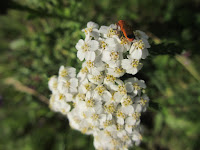 |
| A young oak planted up in-front of a mature oak. It will in time take its place. |
 |
| Parkland consists of open grown trees. (rich in lichens and beetles) |
A limited number of cattle grazing the parkland at St. Catherine's is key to maintaining such a diversity of species.
Cattle do not graze vegetation as close down to the ground as sheep. Unlike sheep, cattle use their tongues to pull tufts of vegetation into their mouths. This often leaves tussocks which benefit insects and small mammals. As they have such wide mouths, cattle do not overgraze or target certain species of plants. This results in a highly diverse habitat.
Credit must be given to the National Trust tenant farmer for his conscientious management of this land which is under an HLS agreement, (Higher Level Stewardship) a habitat management scheme.
Cattle are excellent at keeping back some of the rank vegetation. In areas where they have broken up the ground, seeds are more easily able to germinate. Here an oak tree seedling is a possible veteran of the future!
Bumblebee on Betony, St. Catherine's. The wildflowers here offer a sustained source of pollen and nectar for the bees during the long Summer months.
Many acres of perennial rye grass have taken the place of the wildflower meadows. This has had a devastating impact on bumblebee numbers. At least two bumblebee species are thought to have become extinct recently with others such as the Great yellow bumblebee and the Shrill carder bee on the brink.
David Attenborough once said,"Bumblebees are key factors in our wildlife. If they disappear many of our plants will not bear fruit."
A bumblebee is covered in pollen on a Cat's Ear flower at St. Catherine's in late July.
Bees are needed to pollinate plants BUT plants are needed for bees to pollinate!
The presence of Quaking Grass is an indicator that unimproved native grassland is being well managed; it is good to see it at St. Catherine's.
A grass roots level view of Harebells, Betony, and Burnet Saxifrage.
Dead wood is left to rot within the parkland. it is a valuable habitat for many invertebrates, some very rare. Here a fallen tree is surrounded by Birdsfoot Trefoil, Black Knapweed and thistles.
Foxgloves with mature parkland trees and younger trees in tree pens in the background.
Foxgloves with mature parkland trees and younger trees in tree pens in the background.
Purple loosestrife in the
wetland area. |
| Sanicle. |
 |
| Yarrow. |
Self heal.
Cranesbill
Tormentil.
Just some of the many species of wildflowers to be seen in the parkland at St. Catherine's in July.
Now...any idea what this one is!? Possibly Bog Stitchwort? Lesser Stitchwort?
In the wetland area is a stand of "nationally scarce" Touch-Me-Not Balsam, an annual plant, which the rare netted Carpet Moth depends upon for its survival; the UK Biodiversity Action Plan classes the moth as a priority species. It is listed as vulnerable in the Red Data Book.
The Touch-Me-Not is growing up against the dry stone wall in the south west corner of the parkland. Invasive non-native Himalayan Balsam is eradicated every year from this area to stop it encroaching, and ultimately displacing the Touch-Me-Not.
Hopefully this post has given some indication of the rich biodiversity that is contained within this small area of parkland called St. Catherine's.
If you intend using the public footpath through St. Catherine's, please pause along the way and have a look around!




















No comments :
Post a Comment